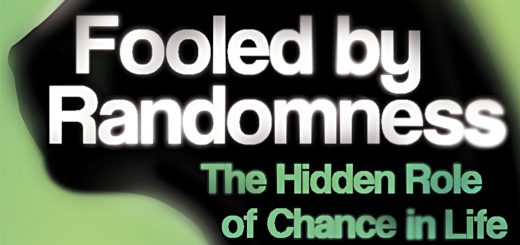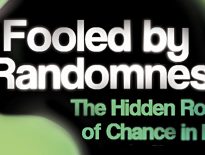Fooled By Randomness 5 – Luck and Nonlinearity

Today’s post is our fifth visit to Nassim Nicolas Taleb’s modern classic Fooled By Randomness.
Luck
Taleb begins Chapter Nine with a discussion of some areas of life where randomness is low, and track record can be relied upon:
- dentistry
- concert piano playing
- sculpture
But not investment management, which suffers from:
- survivorship bias
- data mining
- data snooping
- overfitting
- and regression to the mean.
[Finance] is one of the rare areas of investigation where we have plenty of information, but no ability to conduct experiments.
Taleb runs a Monte Carlo with 10,000 managers who win or lose on the toss of a coin.
- After five years, 313 managers will have made money each year via pure luck.
If we throw one of these successful traders into the real world we would get very interesting and helpful comments on his remarkable style, his incisive mind, and the influences that helped him achieve such success.
And the following year, should he stop outperforming they would start laying blame, finding fault with the relaxation in his work ethics, or his dissipated lifestyle. The truth will be, however, that he simply ran out of luck.
Taleb reruns the game with a 45% chance of winning (ie. a negative expected return).
- After five years, there are still 184 managers (almost 2%) who have been positive each year.
The expectation of the maximum of track records, depends more on the size of the initial sample than on the individual odds per manager.
The more investment managers, the more “excellent” managers.
In real life, the larger the deviation from the norm, the larger the probability of it coming from luck rather than skills.
Taleb ties the impersistence of such outperformance to regression to the mean.
- He equates the survivorship bias to the difference between the average of the best performers and the average of the entire sample.
A good example is the reviews on a book jacket – they are of course not representative but are the best reviews the book has received.
I never said that every rich man is an idiot and every unsuccessful person unlucky, only that in absence of additional information it is safer to reserve one’s judgment.
Reverse Survivors
The same logic applies to the skilled person who has the odds markedly stacked in her favor, but who still ends up going to the cemetery. All one needs is two bad years in the investment industry to terminate a risk- taking career
People maximize their odds of staying in the game by taking black-swan risks (like John and Carlos)–those that fare well most of the time, but incur a risk of blowing up.
Some managers take the opposite route, and become closet indexers.
The Birthday Paradox
If you meet someone randomly, there is a one in 365.25 chance of your sharing their birthday. Where there are 23 people in a room, what is the chance of there being 2 people with the same birthday? About 50%. For we are not specifying which people need to share a birthday; any pair works.
“It’s a small world!” is often uttered with surprise. But these are not improbable occurrences -we are not truly testing for the odds of having an encounter with one specific person, in a specific location at a specific time. “Rather, we are simply testing for any encounter, with any person we have ever met in the past, and in any place we will visit.
This is the equivalent of data mining or data snooping.
- Here the rule for outperformance (or surprise) is retro-fitted to the available data.
A random series will always present some detectable pattern.
Earnings Season
Taleb extends the Monte Carlo result for investment managers to earnings reports.
- After three years, 12.5% of companies will have a random track record of positive earnings surprises.
The stock review committee at the investment house will give your broker their names as “strong buys.” The manager in charge of your 401(k) retirement plan will be acquiring the entire list.
He imagines an investor in 1900 buying not just US stocks, but also Russian and Argentinian companies.
- Once again I think this is a reasonable strategy, assuming that the allocations are modest, and you are prepared for some of the selections in your diversified portfolio to fail.
Cancer
Carl Sagan studied cancer cures from visits to the holy waters of Lourdes and that the cure rate was lower than that for spontaneous remissions.
Taleb looks at cancer clusters.
Consider a square with 16 random darts hitting it with equal probability [of location]. If we divide the square into 16 smaller squares, each will contain one dart on average – but only on average.
One dart in each square would seem an unusual result (though it is as likely as any other).
- We would expect to see clusters.
In the real world, this entirely expected result means that:
Some newspaper will declare that one of the areas harbors radiation that causes cancer.
Science generally has a strong survivorship bias:
Research that yields no result does not make it to print. The problem is that a finding of absence and an absence of findings get mixed together.
Nonlinearity
Life is unfair in a nonlinear way. A small [or non-existent] advantage in life can translate into a highly disproportionate payoff.
Taleb uses the example of a sandcastle which eventually collapses under its own weight to illustrate non-linearity.
- But most people will be familiar with the phrase “the straw that broke the camel’s back” and with The Butterfly Effect.
The success or otherwise of an actor is another good example, as it the first-mover advantage of the deliberately innefficient QWERTY keyboard, which has proved impossible to dislodge.
This is called a path dependent outcome.
The network externalities of the internet have made first-mover advantage more important than ever (Taleb uses Microsoft as an example, but there are many others).
Nonlinear dynamics are studied under chaos theory.
- Population models and weather forecasting are popular applications.
These processes can be modelled using Polya maths:
Assume an urn initially containing equal quantities of black and red balls. You are to guess each time which color you will pull out before you make the draw.
Unlike a conventional urn, the probability of guessing correctly depends on past success, as you get better or worse at guessing depending on past performance. The probability of winning increases after past wins, that of losing increases after past losses.
This leads to a huge variation in outcomes.
Taleb says that the maths used in economics is the wrong kind:
Someone in a great rush decided to introduce mathematical modeling techniques without considering that the class of mathematics they were using was too restrictive for the class of problems.
The important fact is knowing the existence of these nonlinearities, not trying to model them.
Hence Taleb’s preference for Monte Carlo.
Not only is the maths inadequate, but our brains also cannot deal with nonlinearity.
There are routes to success that are nonrandom, but few, very few, people have the mental stamina to follow them. Those who go the extra mile are rewarded. Most people give up before the rewards.
Conclusions
That’s it for today.
- We’ve processed another two chapters and remain on course to complete the book in seven articles (plus a summary).
Next up are probability blindness and gambler’s ticks.
- Until next time.














